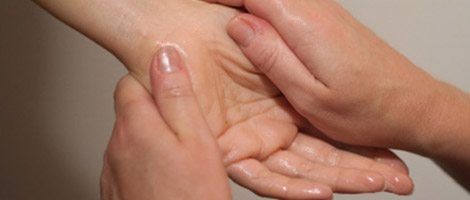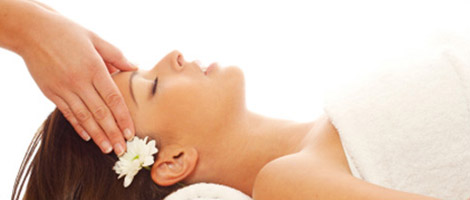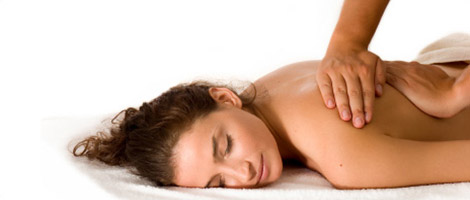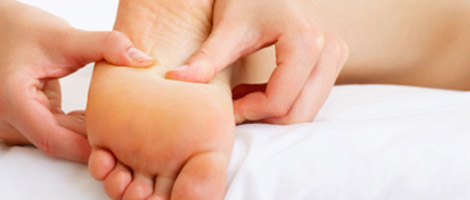
Hand Massage
Our hands do it all: heavy lifting, intricate movements, and repetitive motion. As a result, they’re a part of the body that is constantly overworked. This article will brief you on the inner workings of this vital appendage and why massaging this area is so valuable. Then we’ll give you a primer on hand massage basics and an instructional on the use of some sensational strokes.
Anatomy 101
The hands are controlled by long tendons and muscles that extend from the elbows. They merge with blood vessels and nerves at the wrist, bundled by a tightly fit ligament called the carpal ligament. When hands become stressed, the ‘tunnel’ contracts and puts great pressure on the three major nerves of the arm. A common example of this condition is carpal tunnel syndrome, a disorder that is caused by repetitive movements that cause stress to the hand and wrist. Hands that perform heavy labour, rather than repetitive tasks, also undergo inflammation, swelling and soreness.
Who Can Benefit from a Hand Massage?
Virtually everyone! The techniques we are about to show you can transform inflamed, oxygen starved hands and make them feel rejuvenated to the point of feeling weightless! A good hand massage doesn’t require a lot of skill to get positive results. Hand massages are easy to self administer and can be carried out with virtually no preparation or staging; however, many of the stroking movements are augmented by the use of massage oil.
5 Basic Hand Massage Tips
1. The fingers, knuckles and even the elbow are all effective to massage the hands. You can use your thumbs, but doing deep work in the palms may cause strain. Wherever possible, use methods that don’t strain or aggravate your own hands.
2. As long as they’re in a comfortable position, your partner can sit up or lie on their back as you sit by their side facing them. Alternatively, situating yourself behind them, have your subject lie flat on their back and lay their hand above their head. Support your subject’s arm and wrist with a pillow as you perform the massage.
3. You are free to use your mouth to kiss and suck on their fingers, palm, thumb and thumb mound. But it might be best to wait until the end of the massage for this, once their hands are rejuvenated. According to tantric philosophy, sensually sucking on the thumb can directly stimulate the genitals, particularly for men.
4. Remember that it feels best when you repeat the strokes and take your time. A few extra minutes spent on a massage translates into days of relief for the receiver.
5. Choose one of the following methods: massage the entire topside, then the entire underside, of the hand, OR alternate sides at every section of the hand like fingers, palm, and webbing.
The Strokes
1. Warming up by the Fire
This invigorating movement is a great way to start a massage. It restores circulation and stimulates blood flow.
Method - Simply hold the receiver’s hand between both of yours and rub slowly at first, then fast. The action is similar to that of rubbing a stick between your hands to make a friction fire. Feel free to blow on them too.
Suggested Use - You start with this move as it warms their hands with the heat of your own. As well, it’s a good way to desensitize your subject if they happen to be ticklish.
2. The Gamer
This position gives you the control you need to thoroughly knead your subject’s hand with your thumbs. Its purpose is to direct concentrated pressure along the muscles of the fingers and hands. Best of all, it’s a skill that many video gamers are familiar with!
Method - Cup the receiver’s hand with both of yours in the same way you would hold a video game controller. Use both thumbs simultaneously to perform the massage. The palm will need firmer pressure while the back of the hand requires a light touch.
Suggested Use - In this position, you can knead their palm and stretch it open, or gently run your thumbs in between small bones of the topside of the hand. Using your fingers underneath as support, make circular (or back and forth) motions with your thumbs; rub the palm and fingers of both sides of the hand.
3. Acupressure
For a deep therapeutic approach, try acupressure. It is a form of massage therapy that involves stimulating acupuncture points using fingers instead of needles. Pressure points in the hand are connected to meridians that, when stimulated, release blocked energy to flow unimpeded to corresponding areas of the body. Six major meridians can be treated by massaging the hands.
Method - Using firm pressure, make quick, concentrated circular movements as you press down on the point. It should last anywhere between 5-15 minutes, but be careful not to over stimulate it – it may exacerbate the condition. How will you know when you find the right spots? They will feel tender when pressure is applied, which is an advantage in helping to find them.
Suggested Use - Pericardium 6 is a point located two inches (five centimeters) below the center of the inside of the wrist. Massaging this can alleviate nausea, motion sickness and morning sickness. Stimulate Large Intestine 4 by squeezing the webbing between your thumb and forefinger and pressing into the first finger. , This can relieve a slew of common ailments: toothache, headache, vertigo, menstrual cramps, and constipation.
4. Bend Forward and Bend Back
This technique provides a much needed stretch for the sore muscles in the hand. This is an excellent stroke to transition to other massage techniques, particularly when your rubdown is releasing a lot of tension. Just make sure you don’t overstretch.
Method - Begin with the underside of their hand. Using one hand to support their hand and wrist, lay your four fingers at a right angle to theirs, and gently press and hold their fingers back. Then, do the same thing with the topside of their hand. Take turns bending forward and back, forward and back.
Suggested Use - Try this move with their wrist bent; it will send the stretch all the way down the fingers, palm and wrist. Do this same technique on the fingers; bend each one each forward and hold, then bend them back and hold. Pay special attention to their thumb. You can also achieve an opening effect on the palm by interlacing your fingers with theirs and gently pulling them downward.
5. Fist Each Finger
This movement is easy for the giver and rewarding for the receiver. You can execute major part of finger massage using just this one move, mainly because there are so many variations.
Method - While supporting their hand with yours, wrap your other hand around one of the receiver’s fingers, with your index finger closest to the knuckle (it helps to compare it to what your hand looks like when it’s enclosed around a ball). All you do after that is squeeze, pull or push.
Suggested Use - First, go around the entire circumference of each finger while gently pumping and squeezing. You can line up your fingertips and use them to direct more pressure to the area. Don’t forget to go up along the nerve-rich sides of the fingers.
Use a key grip to modify the sensation. Begin with the original approach but hold on to their finger as though you were holding a key (with your thumb resting on your forefinger). As you knead with your thumb, make small rotations up and down the length of the finger and all the way around. You can also massage each finger using a forward and back motion with your thumb.
Employ the same key grip but this time, as you gently pull down the finger away from the knuckle, make a twisting motion (as if you were turning a doorknob). Then with the same twisting motion, push back up the finger again.
6. The Handshake
If your subject does any degree of physical labor, pay special attention to this stroke. This move will both squeeze and stretch taut the muscles of the hand.
Method - Engage this position by reaching to shake hands with your subject’s wrong hand. Slide your hand in until your thumb web meets theirs. This will naturally cause your thumb to rest on the fleshy base of their thumb. Rub all around the mound with long strokes.
Suggested Uses - Once you’ve paid enough attention to the mound, rub all along their thumb bone. While you’re at it, reach your thumb toward the depression in the center of the palm and rub. Not only is it a convenient fit, it is an easy movement to alternate the Handshake with.
7. Spread the Palm
Because the palm rarely gets stretched into opening, this technique will send shivers down your subject’s spine. Spread the Fan combines two soothing elements of massage: stretching and kneading. It also employs a rather interesting grip; you interlock your outer fingers with the subject’s outer fingers to pull back away from their palm, creating a deep stretch.
Method - Hold your hands out in front of you with your palms facing up, fingers open and pinkies almost touching. Have your subject do the same thing starting with their right hand. The webbing between your own pinkies and ring fingers will be the anchor points of this move. Slide your left hand into their thumb web and your right hand into their pinkie web; make sure that your pinkies face down and that your fingers come around to support the wrist on the topside of their hand. In the final pose, your hands stretch open their palm and have a great fulcrum with which to thumb knead with.
Suggested Use - This can create an incredibly deep stretch so be caution of how hard you pull. Alternate between stretching and thumb kneading.
8. Brushing
This is a finale without a lot of pomp. Brushing adds yet another sensation to the hand massage as you wind it down by lightly gliding your fingers all over the subject’s entire hand and wrist.
Method - Starting at the wrist, gently caress the hand using long, slow sweeps.
Suggested Use - The subject’s hands will be so revived that even the slightest touch will feel magnetic. Take your time with this move.
Final Thoughts
The beauty of a hand massage is that everyone can relish these strokes. Rather than feeling tight, the hand feels supple and deliciously stimulated. The only question that remains is “what are you going to ask them to do with their hands to thank you in return?"


